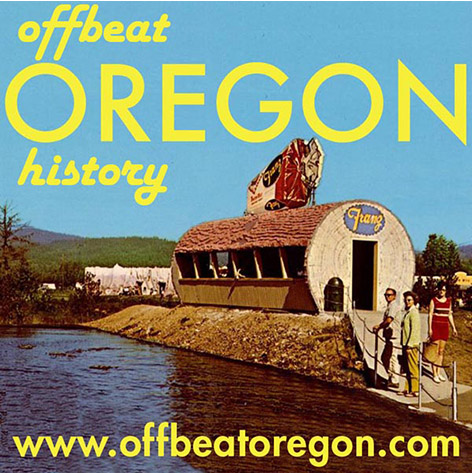FLORENCE, LANE COUNTY; 1970s:
Oregon’s world-famous exploding whale
Audio version: Download MP3 or use controls below:
|

Right now, though, Uemenhoefer was not thinking about his mission. He was trying to explain to Thornton why using 20 cases of dynamite was the wrong decision here. What was really needed, he told Thornton, was a small charge, like 20 sticks, to push the whale off the beach and into the sea; or a much, much bigger one that would totally vaporize it. Twenty cases, he said, was just enough to make a big mess, and maybe hurt some people. Thornton blew the know-it-all stranger off. “The guy says, ‘Anyway, I’m gonna have everybody on top of those dunes far away,’” Uemenhoefer told reporter Wayne Freedman of San Francisco TV station KGO in an interview 25 years later. “I says, ‘Yeah, and I’m gonna be the furtherest SOB down that way!’” And so he would. But if Uemenhoefer thought his involvement in the exploding-whale project was over, he was sadly mistaken. Finally, after moving all the spectators about a quarter-mile down the beach and away from the blast site, Thornton and his crew took cover, pushed the plunger … and filled the sky over Florence with noise, smoke, sand and bits of dead whale.
IF YOU SEARCH for “exploding whale” on YouTube, you’ll readily find the KATU-TV story that reporter Paul Linnman and cameraman Doug Brazil filed that night. It does a spectacular job of showing the whole event: the massive explosion (“like a mighty burst of tomato juice,” Linnman recalls in the book); the yells of delight turning to quavering shrieks of fear as the tiny specks visible above the crowd grow larger and it becomes clear that slabs of rotting meat, ranging in size from pinhead-size bits to refrigerator-sized chunks, are now falling out of the sky. You’ll hear possibly the most unintentionally comic part of the whole clip: A woman’s motherly voice behind the camera saying, “All right, Fred, you can take your hands out of your ears now … here come pieces of … oh my g—” You’ll also see what happened to Walt Uemenhoefer’s brand-new 1971 Oldsmobile Ninety-Eight Regency. A chunk of flying whale meat the size of a coffee-table top had dropped out of the sky directly onto the roof of the big luxury car, blowing glass out in all directions and leaving its top flatter than its owner’s military haircut. “My insurance company is not gonna believe this,” Uemenhoefer remarked ruefully when he saw what had happened. But he had to chuckle later on, when he remembered the sales promotion that had been going on at Dunham Oldsmobile in Eugene when he’d bought the car just a short time before. It was taglined, “GET A WHALE OF A DEAL ON A NEW OLDSMOBILE.” “Fortunately, no human was hurt as badly as the car,” Linnman said in his newscast. “However, everyone on the scene was covered with small particles of dead whale.” Uemenhoefer, by the way, was later better known as the titular “Baron” of The Baron’s Den, a gun store and indoor shooting range just south of Eugene in Goshen, visible from Interstate 5 (it usually sports a big blue banner that reads “SHOOT A REAL TOMMY GUN”). He died at the age of 84 in January of this year.
IN THE AFTERMATH, Thornton was spinning hard — or trying to. “It went just exactly right,” he told Larry Bacon of the Eugene Register-Guard. “Except the blast funneled a hole in the sand under the whale” (thereby causing some of the whale chunks to be blown back toward the parking lot, he went on to say; this was his on-the-spot explanation for the whale-meat shower to which he'd accidentally treated all the bystanders). Decades later, Thornton — who also died recently, in October 2013 — was still defiantly sanguine about the whole affair. Contacted by Linnman in the mid-1990s, he refused to be interviewed on camera, and seemed to feel that news coverage of the event had converted a successful operation into a public-relations disaster. The conversation ended on a sour note when Linnman asked Thornton if he didn't want to tell the public about it — about what had gone wrong that day. “What do you mean, ‘what went wrong?’” he asked Linnman tersely — apparently by way of implying that nothing had.
|
Background photo is a hand-tinted image of a fish wheel on the Columbia River near Beacon Rock, published circa 1910 on a picture postcard.
Scroll sideways to move the article aside for a better view.
Looking for more?
On our Sortable Master Directory you can search by keywords, locations, or historical timeframes. Hover your mouse over the headlines to read the first few paragraphs (or a summary of the story) in a pop-up box.
... or ...

©2008-2016 by Finn J.D. John. Copyright assertion does not apply to assets that are in the public domain or are used by permission.

